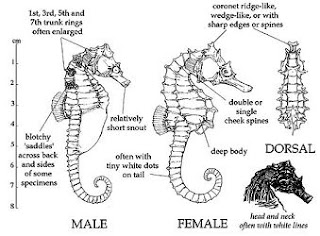The Lined Seahorse (Hippocampus erectus), also known as the
Northern Seahorse or Spotted Seahorse, is one of the larger species of its kind
and is easily distinguishable by its colouring pattern of dark lines on a light
background. The seahorse is an interesting
looking fish because of its resemblance to a knight on a chess board. From its
horse-like head to its prehensile tail it does not resemble many peoples’ idea
of what a fish looks like. Rings of
rectangular bony plates have replaced scales on the Lined seahorse and one of
the most distinguishing features is the kangaroo-like pouch that the males of
the species have. They use this pouch
during reproduction; the female seahorse will deposit from 250 to 650 eggs into
this brood pouch where they will be fertilised and incubated until the babies
are developed enough to swim freely on their own. Once they have matured to
this point the male will make sharp movements bending back and forth to expel
the young from the brood pouch. When they are born they are exact miniatures of
adult seahorses at about a size of approximately 1.5cm. The seahorse will reach its maximum length of
12.5cm in 8 to 10 months. The Lined
seahorse may live up to 4 or 5 years.
It is also important
to note that seahorses are currently in danger of being wiped out due to their
use in traditional Chinese medicine and their use as novelty items for personal
aquariums and tourist products. Here at
the Huntsman Marine Science Centre, we hope to create a Lined Seahorse exhibit
and to help offset the depletion of these interesting creatures; a breeding
program as well. To learn more about these creatures and how
you can help please visit http://huntsmanmarine.ca/subcontents.php?id=16&sid=60
.
Adult Lined or Northern Seahorse.
Diagram of both the male and female Hippocampus erectus.
Newly hatched seahorses.


















